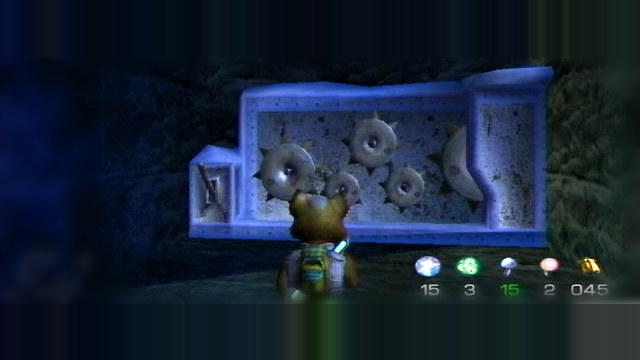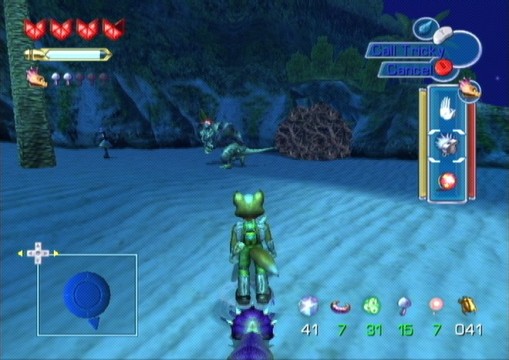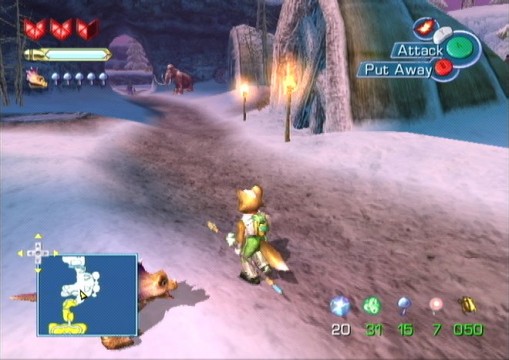
Star Fox Adventures occupies an unusual place in the gaming consciousness– as the final Rare title developed for a Nintendo platform, it serves as a bittersweet reminder of the two companies’ long and fruitful partnership; as an adventure game, it proves to be a competent but derivative take on the Zelda formula; and as an entry in the Star Fox series, it represents the first step in the franchise’s creative decline. Your perception of the title will likely fall into one of these three categories, but the truth remains that Star Fox Adventures is one of the most polarizing and stigmatized titles in Nintendo’s history. Lost amid these conflicting opinions, however, are the game’s merits. You see, despite how conservative the title may be, it also introduced some very creative ideas to its genre that the Zelda series could certainly benefit from assimilating.
This is most immediately apparent in the game’s controls. While largely reminiscent of the scheme employed by the two Nintendo 64 Zelda titles, Star Fox Adventures also introduced the novel concept of a real-time inventory menu, mapping it to the C-Stick instead of the pause button. This allowed players to access all of their items in the midst of play without disrupting the flow of the game, something the Zelda series has often had trouble with. One need only to look to Ocarina of Time’s Water Temple for proof: having to frequently pause the game in order to don the Iron Boots made the dungeon an exercise in tedium, and it has since become one of designer Eiji Aonuma’s most vocal regrets. The recent 3DS remake largely rectified this by incorporating touch controls for easier access to your items, but Rare’s take on the inventory system still stands as the most intuitive solution. Perhaps Wii U’s tablet controller could allow for a similar approach to real-time item management, but whether or not Nintendo chooses to follow suit will ultimately depend upon the extent to which the company intends on utilizing the controller’s features. Still, this approach would greatly simplify the process of sifting through your inventory and make the title more user-friendly for newcomers and veterans alike.

Another facet of Star Fox Adventures that was particularly impressive was the way the game incorporated Prince Tricky into its gameplay. Partner characters are certainly not a foreign concept to the Zelda series– both Nintendo 64 titles assigned to Link a fairy guide to assist him in his journey, and The Wind Waker introduced the “Command Melody,” a song that allowed you to temporarily control one of the various companions you would meet throughout the game. But while these may seem conceptually similar to Prince Tricky’s role in Star Fox Adventures, where they differ is in their versatility: even in Wind Waker, which gave you direct control over your partner, you had to briefly abdicate command over Link to do so, and the opportunity for this was often restricted to specific areas like temples. Tricky, thanks in part to the aforementioned real-time inventory system, could be utilized at any point in the game, and by issuing orders on the fly the little dinosaur could complete tasks independently of Fox’s actions. This certainly streamlined the process of controlling your companion character, but the biggest benefit of this approach was how naturally it could be integrated into the game’s overarching design– the environments were littered with puzzles that could only be solved with Tricky’s help, making him indispensable in navigating the planet. That he would gradually increase his skill set during the course of the adventure further enhanced this mechanic, adding an almost Metroid-like quality to the game. This made traversal a much more nuanced process and helped keep the player engaged throughout the entire experience.
Perhaps most innovative was the way Star Fox Adventures seamlessly integrated dungeons into its world. It is true the title had its share of traditional Zelda-like temples (which I will touch upon further below), but the majority of its challenges were generally more unconventional. The reason for this is largely due to their presentation: rather than being distinct, self-contained ruins through which you must explore, the dungeons in Star Fox Adventures felt like organic extensions of the overworld. Nowhere was this more apparent than in the Dark Ice Mines. While the area may have initially resembled one of Sauria’s many locales, where it differed was in the inordinate complexity of its layout: Fox had to engage in a number of activities, from solving puzzles to assisting non-playable characters, in order to progress through its innards, and his efforts ultimately culminated in an epic battle with the game’s first major antagonist. On paper all of these disparate elements seem like the kinds of challenges that are typically found in a conventional dungeon, but the Mines’ unorthodox layout helped masquerade it as just another area of the overworld, making your progress through the game feel much more natural as a result.

As I briefly mentioned above, Star Fox Adventures also had two temples in the traditional sense, but what set them apart from the many found in the Zelda series was their structure: unlike in the Zelda games, the temples in Rare’s title had to be revisited at later points in the adventure, each time setting forth a different pathway through its corridors. This, incidentally, is the one idea the Zelda series has already experimented with: both DS installments, Phantom Hourglass and Spirit Tracks, hinge their respective tales around a large temple that must be gradually conquered, and the two games have consequently been praised for their efforts to buck the series’ conventions. It is not a stretch to say they owe this idea to Star Fox Adventures. Their implementation is startlingly similar to Rare’s– if you may recall, Fox was charged with returning Sauria’s lost Spell Stones to the planet’s two Force Point Temples, and each one he acquired would unlock a previously-unexplored section of its corresponding sanctuary. These areas, while not particularly long in duration, presented their own unique puzzles and challenges for players to overcome, making them in effect two temples in one. Such an idea was considerably novel for its time, especially for a title that so closely followed the Zelda template, and it helped differentiate the game from its more popular inspirations.
While Star Fox Adventures may not be regarded as one of Rare’s best efforts, the game should be lauded for tempering the Zelda mold with some truly innovative concepts. The real-time inventory menu in particular was an inspired touch that streamlined item management, and the game’s unique approach to dungeons and temples helped mask their contrivances by integrating them naturally into its virtual world. The title may admittedly have more than its share of faults, keeping it from reaching the same lofty heights as some of the developer’s other creations, but as we can clearly see, it was still able to introduce some forward-thinking ideas to what was even then becoming a standardized formula.




 ShareThis
ShareThis







Great article. I’ve always really liked Star Fox Adventures— I’d even go so far as to say it’s perhaps one of my favourite GameCube games.
I definitely agree on the real-time inventory point. That would be a really great addition to Zelda. From what I’ve played of Skyward Sword, it’s more of a return to the menu style in Twilight Princess, but it doesn’t freeze the action completely, so perhaps there’s some scope for a slightly more real-time menu in the future.
Another thing I really liked about SFA was the seamless overworld you mentioned. I was even more impressed by the lack of loading times when I first played it, although I’m pretty happy with how Zelda deals with its dungeons at the moment. It would be nice to seem them try something like this though at some point.
I think the partner problem was something very specific to The Wind Waker though. I can’t see Link having a partner like Ricky any time soon as it would make the whole Triforce configuration a bit weird (unless it’s a game not involving the Triforce, of course!). Either way, it certainly would have made those Wind Waker dungeons a lot better if the sages had been like Ricky!
Thank you! :)
I agree that the partner mechanic of SFA may not exactly fit into a Zelda game (at least insofar as it was incorporated in Rare’s title), but I think it’s a common enough element of Link’s adventures that the suggestion wasn’t entirely unwarranted. I was actually going to list Spirit Tracks as a more successful example of the series experimenting with the idea, but then I realized that it too limited your companion’s use to a single temple. XD
Unfortunately, I never got round to playing SFA, but I like the idea of real time inventory,it would make the action much more immersive!
I agree that Zelda needs to start branching out and an open world Dungeon type design would be great (it is sublime in Dark Souls) Would love to see it happen sometime in the future.
The game definitely had its faults, but it was still one of my favorite GameCube titles. I’d definitely recommend checking it out if you had the ability to (and were tolerant of some rather questionable design decisions).
I’m actually really interested in playing Dark Souls, but I’ve found I have little patience for gaming anymore, so I don’t think it would be good for my blood pressure. XD
Never played this game, that inventory system would be pretty cool for a zelda game, and i think the dungeon dinamic for skyward sword is more like the one istar fox adventures, with the dungeons becoming part of the general field and not hiding apart in a tree or a cave or a lake.
I’ve been on a Skyward Sword blackout so I wasn’t aware of this, but it’s certainly piqued my interest in the game even further!